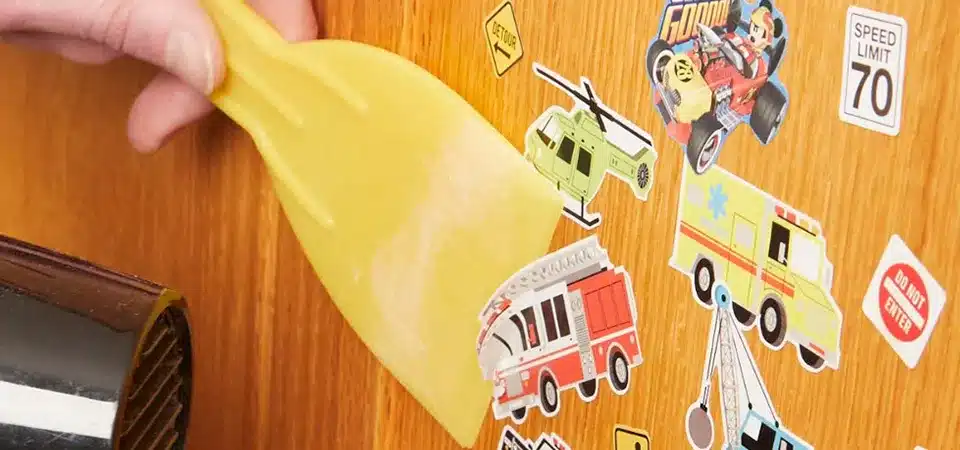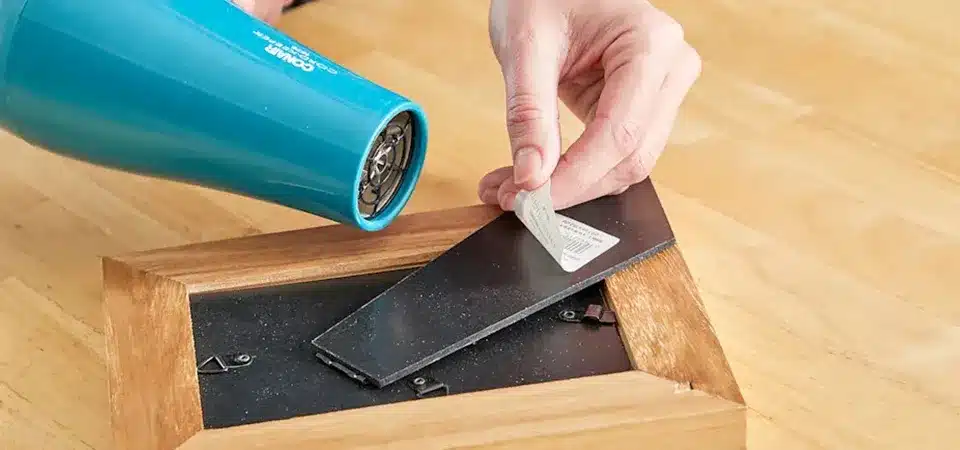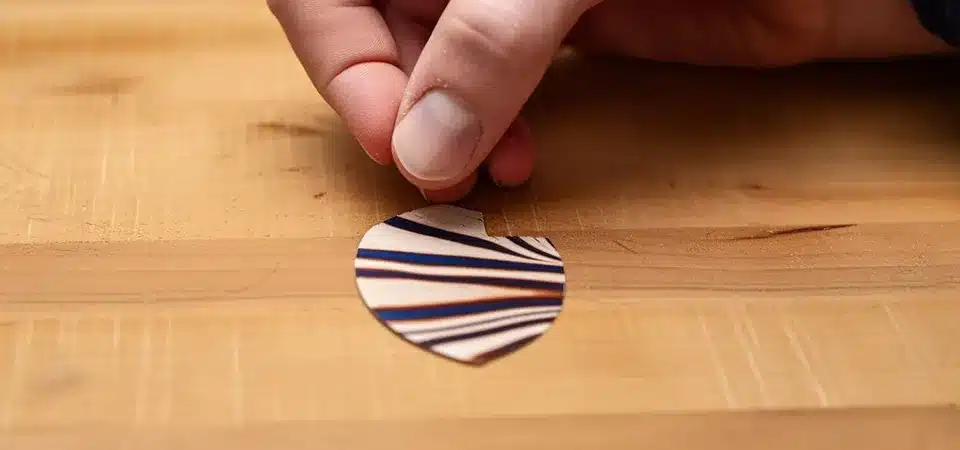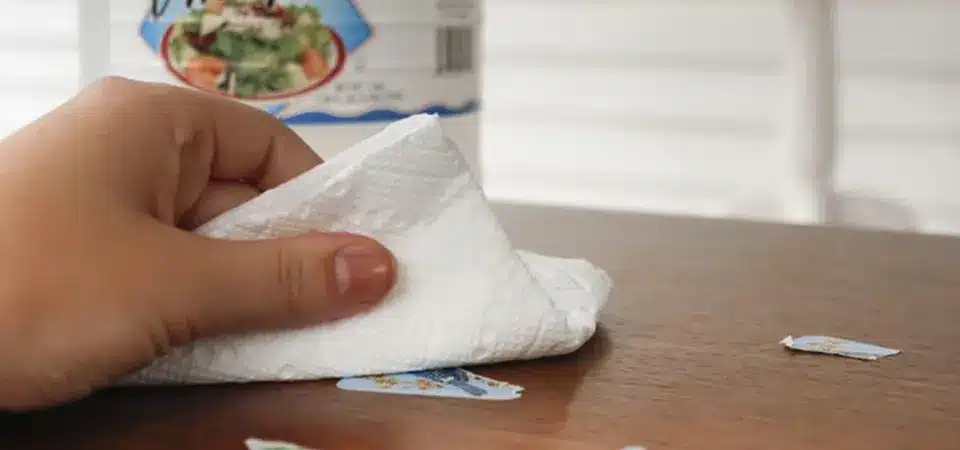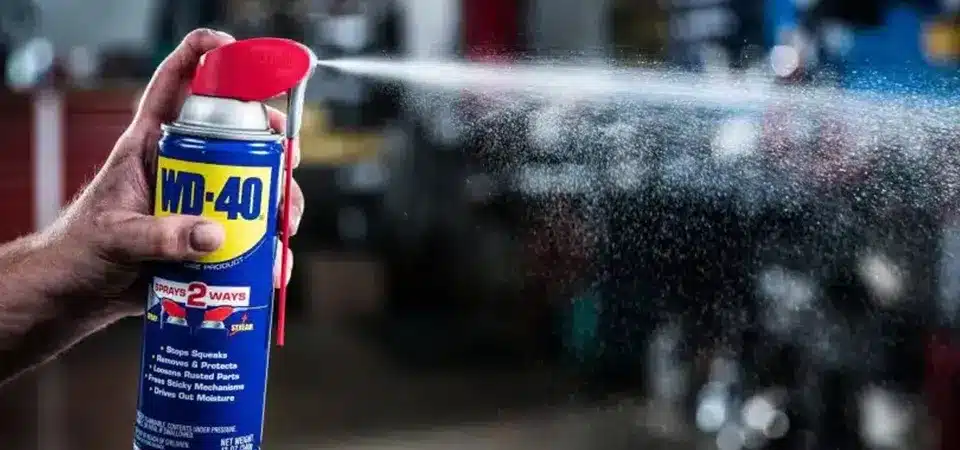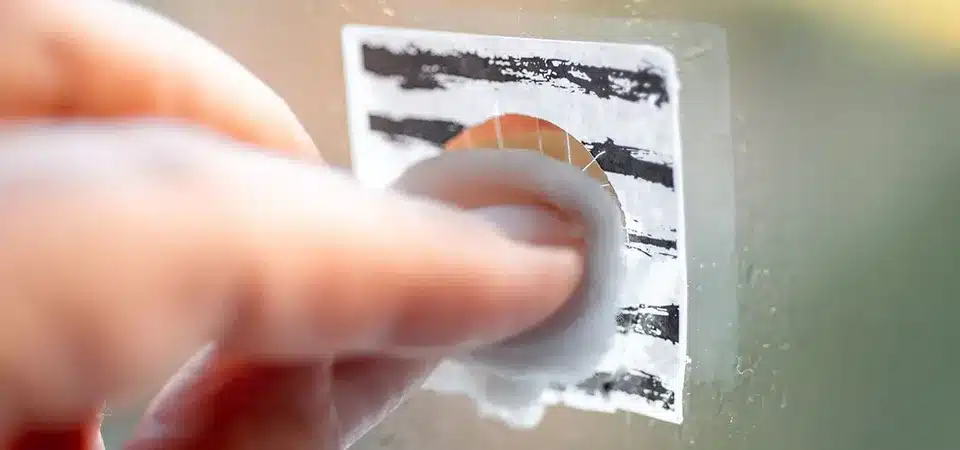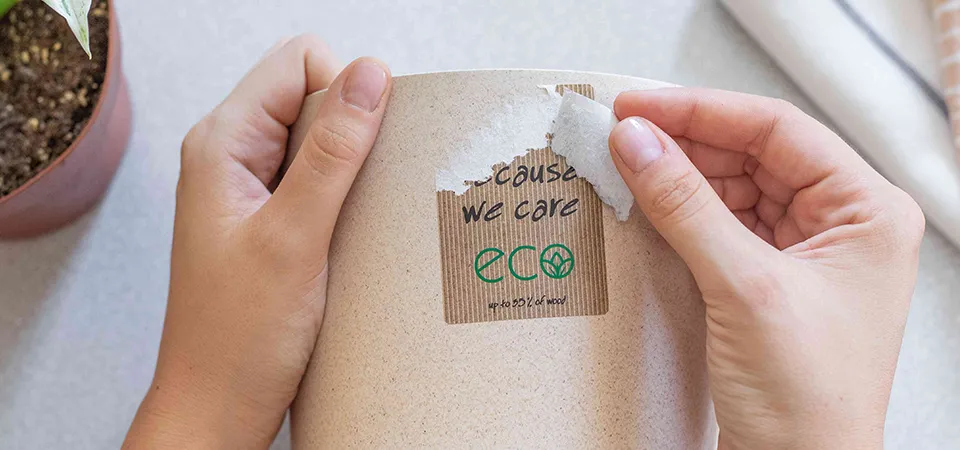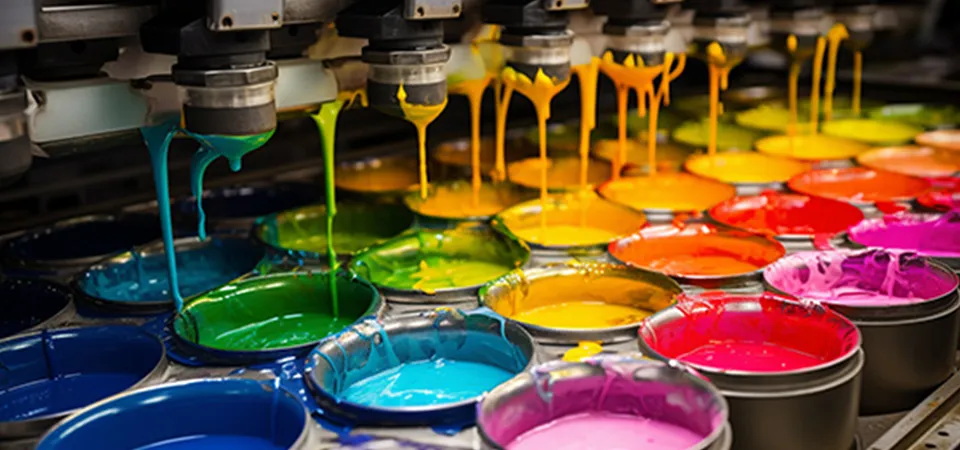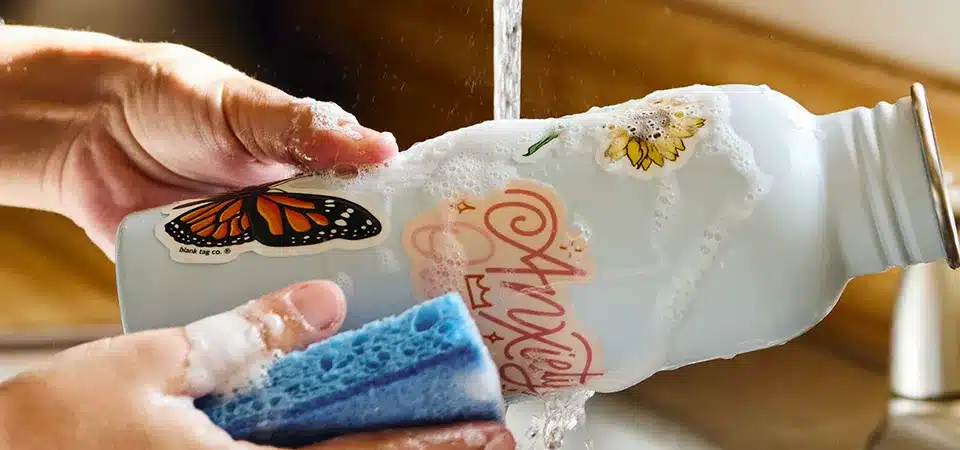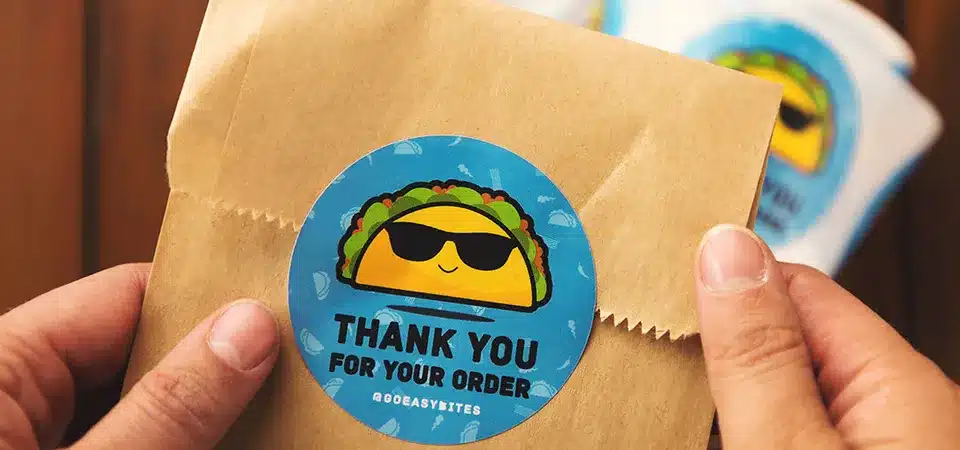Trying to remove a sticker from wood can leave scratches or sticky goo. This damages your beautiful furniture, making a small problem a permanent eyesore.
To remove stickers from wood, gently warm the sticker with a hairdryer to loosen the adhesive, then peel it off. For stubborn residue, apply a mild oil like vegetable oil or a solvent like white vinegar, let it sit, then wipe away. Always test on a hidden area first.
I've seen it all in my sticker business—from high-quality removable labels to cheap paper ones that become part of the furniture. Wood is particularly tricky because it's a natural, porous material. One wrong move with a harsh chemical or a sharp tool, and you can cause permanent damage. Let’s walk through the safest methods, starting with the most important step: precautions.
What precautions should you take before removing a sticker from wood?
You reach for a scraper or a strong chemical to remove a sticker. But this quick fix can strip the wood's finish or leave a deep scratch, causing irreversible damage.
Before starting, identify the wood's finish (sealed, painted, or unfinished). Always test your chosen removal method on an inconspicuous spot, like the back or underside, to ensure it doesn't cause discoloration or damage. Work slowly and gently.
In my experience, this testing step is the single most important part of the entire process. Wood finishes can be unpredictable. Unfinished wood will act like a sponge, absorbing any oil or liquid and creating a permanent stain. Sealed wood, which is covered with a protective layer like polyurethane or varnish, is much more resilient but can still be dulled or softened by harsh chemicals. Painted wood is also vulnerable, as some solvents can lift the paint right off along with the sticker glue. Use soft tools like a plastic scraper, an old credit card, or a soft cloth. Never use a metal razor blade, as it will gouge the wood almost instantly. Patience is your best tool.
How can a hair dryer safely remove stickers from wood?
You try to peel a sticker, but it rips, leaving half behind. Scraping at the torn pieces threatens to scratch the delicate wood surface beneath it.
Use a hairdryer on a low or medium heat setting. Hold it a few inches from the sticker and move it back and forth for about 30 seconds to warm and soften the adhesive, allowing the sticker to be peeled off cleanly.
This should always be your first attempt. It's the least invasive method and is surprisingly effective, especially for vinyl or foil stickers. The goal is not to cook the sticker, but just to make the adhesive pliable. Hold your hairdryer a safe distance (6-8 inches) from the surface and keep it moving constantly to distribute the heat evenly. After about 30 seconds, test a corner with your fingernail. If it lifts easily, continue to peel it back slowly, keeping the warm air aimed at the separation line. If it still resists, apply heat for another 30 seconds. This method usually removes the sticker and the adhesive in one go, leaving no residue behind. It's safe for almost all finished wood, but be cautious with delicate finishes like shellac or old lacquer, which can be sensitive to heat.
Is vegetable oil a safe way to remove sticker residue from wood?
You’ve peeled the sticker, but a sticky, dust-grabbing patch remains. Harsh cleaners can harm the wood’s finish, leaving a dull, discolored spot on your furniture.
Yes, common oils like vegetable, olive, or baby oil are very safe for most sealed wood finishes. The oil soaks into and breaks down the adhesive, making it easy to wipe away.
This is my favorite gentle method for leftover residue. The science is simple: the oil penetrates the sticky adhesive and dissolves its bonds, turning it from a tough film into a soft sludge. Just apply a small amount of oil to a paper towel or cloth and rub it into the residue. For tougher spots, you can apply the oil directly and let it sit for an hour or two. This gives it time to work deep into the glue. Afterward, you should be able to wipe the gunk away easily with a clean cloth. The most important thing to remember is this method is ONLY for sealed wood. If you use this on unfinished, raw wood, it will leave a permanent dark oil stain. After you've removed the residue, wipe the area with a cloth dampened with a little mild soap and water to remove any excess oil.
How do you use white vinegar to remove stickers from wood?
You need something stronger than oil for a stubborn paper sticker. But you're worried that chemical solvents will be too harsh and damage your wooden tabletop.
Dampen a cloth with white vinegar and lay it over the sticker or residue. Let it sit for five to ten minutes. The mild acid in the vinegar will break down the glue, allowing you to wipe it away.
When oil isn't quite strong enough, vinegar is a great next step. The acetic acid in vinegar is an excellent natural solvent that works wonders on the kind of adhesive used on paper labels. Soak a corner of a cloth or paper towel, lay it on the problem spot, and just walk away for a few minutes. This gives the vinegar time to saturate the paper and dissolve the glue underneath. After letting it sit, use the cloth to rub the residue off in a circular motion. You might need to use a plastic scraper for any remaining bits. Because vinegar is acidic, the "test in a hidden spot" rule is extremely important here, as it can potentially dull some very sensitive finishes. Once you're done, wipe the area with a cloth dampened with plain water to remove any lingering vinegar, and dry the surface thoroughly.
Will petroleum jelly or a vaporizing rub remove sticker glue from wood?
The sticker residue is gummy and just won't budge. You need a method that can stay in place on a vertical surface, like a door or cabinet.
Yes, the thick texture of petroleum jelly or a vaporizing rub is perfect for this. They cling to the surface while their oil-based ingredients work to dissolve the sticky adhesive.
This is just a clever variation of the oil method. The problem with using a liquid oil on a cabinet door or the side of a desk is that it runs right off. Petroleum jelly and vaporizing rubs solve this problem. They have a thick consistency that allows them to stay put, giving the oils inside them plenty of time to soak into and break down the sticker glue. Simply smear a thick layer over the entire sticker or residue patch. Let it sit for at least a few hours; for really stubborn, dried-on glue, you can even leave it overnight. The next day, the adhesive will have softened into a gummy paste that you can easily wipe or scrape off with a plastic card. This is only for sealed wood surfaces, and be sure to clean the area with warm, soapy water afterward to remove the greasy film.
When should you use a commercial glue remover on wood?
You've tried everything, but a stubborn, hardened adhesive remains. This last resort feels risky, as you've heard these products can destroy wood finishes.
Use a commercial remover as a last resort for the toughest residue. Choose a citrus oil-based product if possible, work in a ventilated area, and always test it on a hidden spot first.
Sometimes you face a truly impossible sticker, maybe one that's been baked on for decades. This is when you might need to reach for a commercial product like Goo Gone, or even WD-40. These products contain powerful petroleum-based solvents that can dissolve almost any adhesive. However, they can also dissolve some wood finishes. A small, hidden test is not just a suggestion—it's essential. Apply a tiny amount of the product to a cloth, not directly to the wood. Dab it onto the residue and let it sit for only a minute or two, then gently wipe. Never let these strong chemicals soak for a long time. Wear gloves and make sure your room is well-ventilated. Afterward, it is critical to clean the area with a mild soap and water solution to remove all traces of the solvent, which could continue to damage the finish if left on the surface.
Conclusion
Removing stickers from wood requires patience. Start with the gentlest method, like heat or oil, and always test first. With care, your wood can be residue-free.
FAQs
How do you get stickers off wood without vinegar?
Use a hairdryer on low heat to soften the adhesive, then peel the sticker away. For leftover residue, apply a safe, oil-based product like vegetable oil, baby oil, or petroleum jelly. Let it sit to dissolve the glue, then wipe it away with a soft cloth.
How do you remove old stickers from wood doors?
Start by gently heating the old sticker with a hairdryer to loosen it. If that doesn't work or if residue remains, apply a thick, oil-based substance like petroleum jelly. Its thickness prevents it from dripping on the vertical surface. Let it sit for a few hours before wiping and scraping gently.
Do stickers come off wood?
Yes, with the right technique. Most stickers can be safely removed from wood. The key is to use a gentle method that targets the adhesive without harming the wood's finish. Patience is more important than force.
What stickers are right for use on wood?
As a sticker expert, I advise using stickers with a "removable" adhesive for wood. These are designed to be removed cleanly without leaving residue. Vinyl stickers with a low-tack adhesive are often a much better choice than permanent paper labels for finished wood surfaces.
Will WD-40 remove stickers from wood surfaces?
Yes, WD-40 is a powerful solvent that will dissolve sticker residue on wood. However, it should be a last resort because it can damage some finishes. Always test it on a hidden spot first, use it sparingly, and clean the area with soap and water afterward.
Will Goo Gone remove sticker residue off wood surfaces?
Yes, citrus-based removers like Goo Gone are effective for removing sticky residue from wood. As with any commercial product, it's critical that you test it on a small, hidden area first to ensure it's compatible with your wood's finish.
Will rubbing alcohol damage wood if I use it to remove stickers?
I strongly advise against using rubbing alcohol. It is a harsh solvent that can dissolve or permanently damage many common wood finishes, including shellac, lacquer, and varnish. It's much safer to stick to gentler methods like oil or mild heat.

